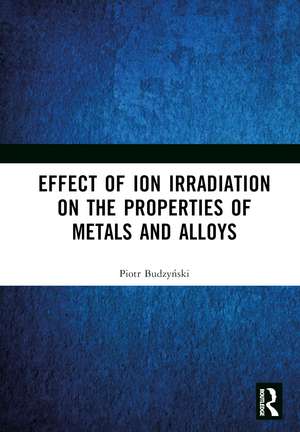Effect of Ion Irradiation on the Properties of Metals and Alloys
Autor Piotr Budzyńskien Limba Engleză Hardback – 31 iul 2024
Effect of Ion Irradiation on the Properties of Metals and Alloys is aimed at academics investigating the properties of metals and alloys after irradiation and/or implantation as well as for students of engineering and physical and chemical sciences. The book is also useful for those looking for up-to-date information on these methods and ways of solving related problems, and for designers of equipment used in places exposed to high ion irradiation or to cosmic space.
Preț: 1111.72 lei
Preț vechi: 1355.75 lei
-18% Nou
Puncte Express: 1668
Preț estimativ în valută:
212.73€ • 231.80$ • 179.25£
212.73€ • 231.80$ • 179.25£
Carte tipărită la comandă
Livrare economică 23 aprilie-07 mai
Preluare comenzi: 021 569.72.76
Specificații
ISBN-13: 9781032629582
ISBN-10: 1032629584
Pagini: 174
Ilustrații: 258
Dimensiuni: 174 x 246 mm
Greutate: 0.53 kg
Ediția:1
Editura: CRC Press
Colecția Routledge
Locul publicării:Boca Raton, United States
ISBN-10: 1032629584
Pagini: 174
Ilustrații: 258
Dimensiuni: 174 x 246 mm
Greutate: 0.53 kg
Ediția:1
Editura: CRC Press
Colecția Routledge
Locul publicării:Boca Raton, United States
Public țintă
AcademicCuprins
Introduction. 1. Interactions of the implanted ions with the target 2. Effects of implantation on the properties of metals and alloys 3. Irradiation with swift ions 4. Effects of ion irradiation on the properties of metals and alloys 5. Synergy of changes in the properties of implanted and irradiated metals 6. Irradiation with neutrons, α particles and electrons 7. Applications of metal irradiation
Notă biografică
Piotr Budzyński, DSc, PhD, Eng, was born in 1971. He graduated from the Mechanical Engineering Faculty at the Lublin University of Technology, where he has been a researcher and academic since 1995. From 2012 to 2020, he held the position of Vice Dean for Scientific Affairs, and in 2020, he was appointed President of the Mechanical Engineering Discipline Council. The Mechanical Engineering Faculty at the Lublin University of Technology is currently one of the leading mechanical engineering research units in Poland.
In 2011, he defended his postdoctoral dissertation titled “The Problems of Friction and Wear of Ion-Implanted Metallic Materials in Mechanical Engineering”. His research interests focus on the improvement of tribological properties of the surface layer in different materials via ion implantation. His recent studies are devoted to the effects of swift-ion irradiation on the properties of materials used in the space technology and in the design of accelerators and nuclear reactors. His research interests also include the design of electronic measuring equipment. He coauthored 58 research publications in journals indexed in the Scopus database as well as two patents and three utility models. He was awarded fellowships at the Horia Hulubei National Institute for R&D in Physics and Nuclear Engineering and the Joint Institute for Nuclear Research.
In 2011, he defended his postdoctoral dissertation titled “The Problems of Friction and Wear of Ion-Implanted Metallic Materials in Mechanical Engineering”. His research interests focus on the improvement of tribological properties of the surface layer in different materials via ion implantation. His recent studies are devoted to the effects of swift-ion irradiation on the properties of materials used in the space technology and in the design of accelerators and nuclear reactors. His research interests also include the design of electronic measuring equipment. He coauthored 58 research publications in journals indexed in the Scopus database as well as two patents and three utility models. He was awarded fellowships at the Horia Hulubei National Institute for R&D in Physics and Nuclear Engineering and the Joint Institute for Nuclear Research.
Descriere
This book describes the interaction between ions and metallic targets as well as energy loss processes during ion implantation and irradiation. Ion bombardments of disks causes changes in surface layer chemical composition, radiation defect formation, sputtering, blistering, swelling, and ion mixing.
